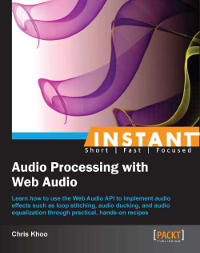HTML5’s web audio API is pretty cool. Last year I had some fun experimenting with it, and since then I have been meaning to loop back and play around with it some more. So when I was offered a review copy of Audio Processing with Web Audio, my interested was piqued and I decided to see what it had to offer.
The book is setup to be a primer for web audio (in Packt terms an “instant” book). It contains a mere 63 pages, and reads like one long chapter. Overall it turned out to be a nice introductory book, but it’s does have a few flaws that take it down a notch.
As the book starts, you’re directed to setup your development environment and to download a zip of the code examples. This zip contains a total of 8 examples, broken out into 6 “recipes”. You can see a list of what they are below.
Recipe 1_1: Initialization exercise
Recipe 2_1: Playing Audio Files from an Audio Buffer
Recipe 3_1: Playing Audio in a Loop
Recipe 4_1a: Setting Volume
Recipe 4_1b: Setting Volume (refactored to use new template code)
Recipe 5_1: Scheduling Audio Playback
Recipe 5_2: Automating Audio Parameters
Recipe 6_1: 5-band Equalizer
For what I assume were space restrictions, the first two recipes in the code example packet were not discussed in the book. This makes the book slightly awkward since the first recipe covered, the one on looping sound (3_1), makes references to text written for these recipes and doesn’t cover concepts that would have been discussed for those examples. Thankfully it’s easy to pick up what you miss from the example code, but it’s an unfortunate editing snafu.
In the looping sound section you’re walked through the creation of the recipe via code samples with explanations, and once it’s done you’re given a deeper discussion of why things worked the way they did. The next two recipes are done in the same vein, and cover volume and automating audio parameters. The example code works smoothly and the author does a great job of explaining all of the little nuances that go with the code.
The final recipe is on building the 5-band equalizer. It’s billed as an advanced example, and it sort of feels like you go from a nice walk through the world of web audio, to a brisk sprint. I really didn’t know what was going on. I don’t know much about sound theory, so the different filters and concepts were all very foreign. I imagine this chapter was included so those more familiar with sound concepts would feel they got something out of the book, but it’s a little confusing for developers not tuned into how sound works.
Looking over the example packet, one other example titled “Scheduling Audio Playback” was cut from the book. However, unlike the first two examples, this exclusion isn’t really noticeable. Still, it leaves me thinking this book could have been a lot more interesting if it had been expanded by 20 or 30 pages. However, I’m glad they included all of the examples in the code packet, since it gives the reader some jumping off points after they’ve finished the text.
Overall it’s a nice introductory book. It has some flaws, but it comes with some good example code and does a good job on the majority of topics it tackles.
